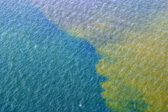Welcome
Karenia brevis has been found off of almost every costal state in the U.S., making it an aquatic, saltwater organism. It not only is found in the U.S., but it is found off the coast of other countries too. Many people know this toxic organism as red tide, but scientists prefer to call it harmful algal blooms (HABs). Learn about K. brevis and its habitat and interactions on this website.
The Florida red tide organism was identified in 1947, but reports of the effects of red tide in the Gulf of Mexico date back to the 1530s. Therefore scientists have been studying this organism for over 50 years, and because of this, there are new techniques and technology that are used to detect, tract, and forecast red tide blooms.
Red tide can be misleading as many people believe it is red in color. In fact that is not the case, as shown in the picture above. Some blooms have a green, purple, or brown hue. Also from the name harmful algal bloom, many people think that all blooms are harmful, when in fact they are not. You can learn more about the blooms and their life history and reproduction on this website.
Begin learning a new tide of information on this poisonous organism by choosing any of the topics listed on the side or start with the classification of this organism.
You can also learn some interesting facts on this page as well that might get you more excited about this toxic organism that is becoming more of a problem. Or start with how this organism gets its nutrients; it might be a bit of a surprise.
Make sure you check out how this organism has adapted to its environment, as Karenia brevis is becoming a more popular topic since it is becoming more of a problem each year.
This semester's theme is venomous and poisonous organisms, but there are a plethora of other organisms you can learn about. You encounter many of these on a daily basis whether you know it or not. You can learn about new organisms as well at MultipleOrganisms.net.
If you would you like to learn more about the author of this page you can check out the contact me page.



